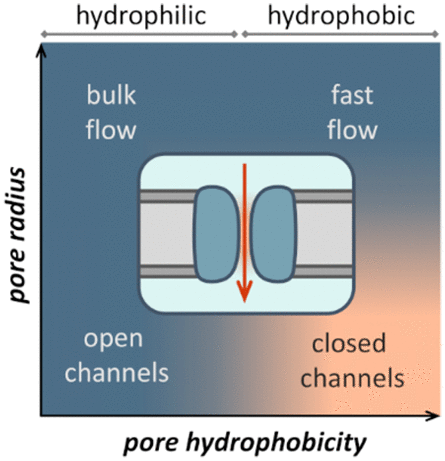当前位置:
X-MOL 学术
›
Chem. Rev.
›
论文详情
Our official English website, www.x-mol.net, welcomes your
feedback! (Note: you will need to create a separate account there.)
Water in Nanopores and Biological Channels: A Molecular Simulation Perspective.
Chemical Reviews ( IF 51.4 ) Pub Date : 2020-08-25 , DOI: 10.1021/acs.chemrev.9b00830 Charlotte I Lynch 1 , Shanlin Rao 1 , Mark S P Sansom 1
Chemical Reviews ( IF 51.4 ) Pub Date : 2020-08-25 , DOI: 10.1021/acs.chemrev.9b00830 Charlotte I Lynch 1 , Shanlin Rao 1 , Mark S P Sansom 1
Affiliation

|
This Review explores the dynamic behavior of water within nanopores and biological channels in lipid bilayer membranes. We focus on molecular simulation studies, alongside selected structural and other experimental investigations. Structures of biological nanopores and channels are reviewed, emphasizing those high-resolution crystal structures, which reveal water molecules within the transmembrane pores, which can be used to aid the interpretation of simulation studies. Different levels of molecular simulations of water within nanopores are described, with a focus on molecular dynamics (MD). In particular, models of water for MD simulations are discussed in detail to provide an evaluation of their use in simulations of water in nanopores. Simulation studies of the behavior of water in idealized models of nanopores have revealed aspects of the organization and dynamics of nanoconfined water, including wetting/dewetting in narrow hydrophobic nanopores. A survey of simulation studies in a range of nonbiological nanopores is presented, including carbon nanotubes, synthetic nanopores, model peptide nanopores, track-etched nanopores in polymer membranes, and hydroxylated and functionalized nanoporous silica. These reveal a complex relationship between pore size/geometry, the nature of the pore lining, and rates of water transport. Wider nanopores with hydrophobic linings favor water flow whereas narrower hydrophobic pores may show dewetting. Simulation studies over the past decade of the behavior of water in a range of biological nanopores are described, including porins and β-barrel protein nanopores, aquaporins and related polar solute pores, and a number of different classes of ion channels. Water is shown to play a key role in proton transport in biological channels and in hydrophobic gating of ion channels. An overall picture emerges, whereby the behavior of water in a nanopore may be predicted as a function of its hydrophobicity and radius. This informs our understanding of the functions of diverse channel structures and will aid the design of novel nanopores. Thus, our current level of understanding allows for the design of a nanopore which promotes wetting over dewetting or vice versa. However, to design a novel nanopore, which enables fast, selective, and gated flow of water de novo would remain challenging, suggesting a need for further detailed simulations alongside experimental evaluation of more complex nanopore systems.
中文翻译:

纳米孔和生物通道中的水:分子模拟视角。
本综述探讨了脂质双层膜中纳米孔和生物通道内水的动态行为。我们专注于分子模拟研究,以及选定的结构和其他实验研究。回顾了生物纳米孔和通道的结构,强调了那些高分辨率晶体结构,它们揭示了跨膜孔内的水分子,可用于帮助解释模拟研究。描述了纳米孔内水的不同水平的分子模拟,重点是分子动力学 (MD)。特别是,详细讨论了用于 MD 模拟的水模型,以评估它们在纳米孔中水模拟中的应用。对纳米孔理想模型中水行为的模拟研究揭示了纳米限制水的组织和动力学的各个方面,包括狭窄疏水性纳米孔中的润湿/反润湿。对一系列非生物纳米孔的模拟研究进行了调查,包括碳纳米管、合成纳米孔、模型肽纳米孔、聚合物膜中的径迹蚀刻纳米孔以及羟基化和功能化的纳米多孔二氧化硅。这些揭示了孔径/几何形状、孔隙内衬性质和水输送速率之间的复杂关系。具有疏水衬里的较宽纳米孔有利于水流动,而较窄疏水孔可能会出现反润湿。描述了过去十年中水在一系列生物纳米孔中行为的模拟研究,包括孔蛋白和β-桶蛋白纳米孔、水通道蛋白和相关极性溶质孔,以及许多不同类别的离子通道。 研究表明,水在生物通道中的质子传输和离子通道的疏水门控中发挥着关键作用。一幅整体图景随之出现,纳米孔中水的行为可以根据其疏水性和半径进行预测。这有助于我们理解不同通道结构的功能,并将有助于新型纳米孔的设计。因此,我们目前的理解水平允许设计纳米孔,以促进润湿而不是去润湿,反之亦然。然而,设计一种能够实现快速、选择性和门控水流的新型纳米孔仍然具有挑战性,这表明需要进一步详细的模拟以及对更复杂的纳米孔系统的实验评估。
更新日期:2020-09-23
中文翻译:

纳米孔和生物通道中的水:分子模拟视角。
本综述探讨了脂质双层膜中纳米孔和生物通道内水的动态行为。我们专注于分子模拟研究,以及选定的结构和其他实验研究。回顾了生物纳米孔和通道的结构,强调了那些高分辨率晶体结构,它们揭示了跨膜孔内的水分子,可用于帮助解释模拟研究。描述了纳米孔内水的不同水平的分子模拟,重点是分子动力学 (MD)。特别是,详细讨论了用于 MD 模拟的水模型,以评估它们在纳米孔中水模拟中的应用。对纳米孔理想模型中水行为的模拟研究揭示了纳米限制水的组织和动力学的各个方面,包括狭窄疏水性纳米孔中的润湿/反润湿。对一系列非生物纳米孔的模拟研究进行了调查,包括碳纳米管、合成纳米孔、模型肽纳米孔、聚合物膜中的径迹蚀刻纳米孔以及羟基化和功能化的纳米多孔二氧化硅。这些揭示了孔径/几何形状、孔隙内衬性质和水输送速率之间的复杂关系。具有疏水衬里的较宽纳米孔有利于水流动,而较窄疏水孔可能会出现反润湿。描述了过去十年中水在一系列生物纳米孔中行为的模拟研究,包括孔蛋白和β-桶蛋白纳米孔、水通道蛋白和相关极性溶质孔,以及许多不同类别的离子通道。 研究表明,水在生物通道中的质子传输和离子通道的疏水门控中发挥着关键作用。一幅整体图景随之出现,纳米孔中水的行为可以根据其疏水性和半径进行预测。这有助于我们理解不同通道结构的功能,并将有助于新型纳米孔的设计。因此,我们目前的理解水平允许设计纳米孔,以促进润湿而不是去润湿,反之亦然。然而,设计一种能够实现快速、选择性和门控水流的新型纳米孔仍然具有挑战性,这表明需要进一步详细的模拟以及对更复杂的纳米孔系统的实验评估。











































 京公网安备 11010802027423号
京公网安备 11010802027423号